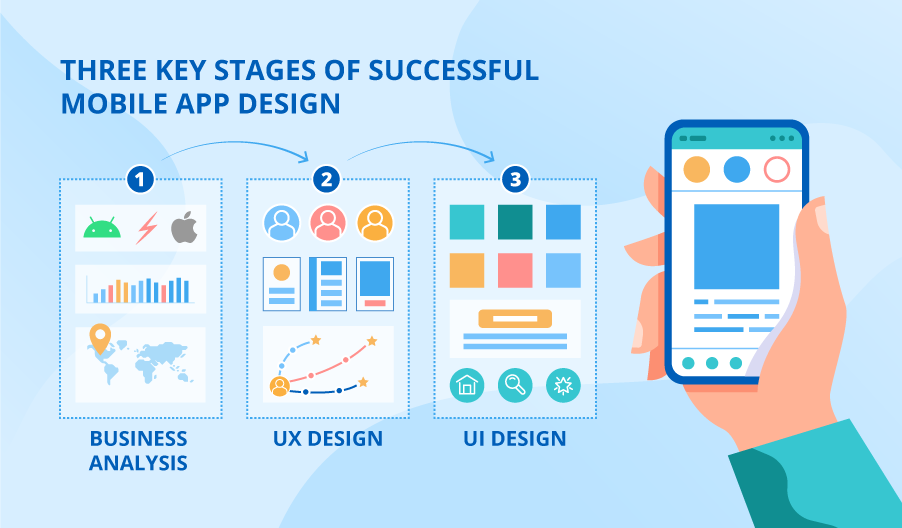Mobile App Design: 3 Key Stages to Your App’s Success
Editor’s note: In the article, Anastasia shares what specific actions contribute to the success of the 3 stages of mobile application design and points out the decisions your project team will be expected to make. To learn even more insider design specifics, feel free to check out ScienceSoft’s user experience design and UI design services.
Mobile app design can appear extremely vague and pose a lot of questions to the businesses that consider requesting it. “What are the steps? What are the artifacts? How many people will be involved, and what will my role be in it?”
In this article, I answer all these questions and more as I explain what lies behind each of the three main stages of mobile application design.

1. Business analysis
At the first stage of any mobile app development project, you need to define the target platform (iOS or Android or both), the development method, and the functional requirements. Although this may sound too techy for a start, I can’t stress enough how heavily further steps depend on the decisions you make at this point. To get a load off your mind and make a calculated and confident choice, I recommend completing this step together with a professional business analyst, who has a focus on mobile design.
To decide on the platform, you will need to define your target audience and analyze their platform preferences that depend on geography and income. For example, if you target an average US user, you will be able to win the audience with just an iOS version. But if you want your app to go global, you won’t succeed without an app version for Android, which is overwhelmingly popular in Europe.
Once you define the platform(s) you need to reach, you should consider the development approach. Your options here are:
- Native development – UX and UI design of the app is tailored to the platform’s original guidelines, it looks and feels exactly like any factory app for that platform. This development option entails high implementation costs but guarantees high user satisfaction.
- Hybrid development – UX and UI design is identical on different platforms and thus may feel unnatural to some users at first. Implementation costs are almost 2x lower than with native development.
- Cross-platform development – UX and UI design offers a near-native look and experience on either platform. This option requires about 70% of the native development budget.
Defining functional requirements is the core objective of business analysis. The requirements help build a detailed concept of your future app and describe all the tasks it will handle in the form of a project specification. Without this document, the UX designers won’t be able to even start their work.
2. UX design
When you’ve defined the functional requirements of your future app, your vendor of choice can proceed to the actual design action. The first stage is user experience design that is usually performed by a UX expert in cooperation with a business analyst.
The team works to create fictional profiles of your mobile app’s future users (aka personas) and their interaction patterns with the application (aka user scenarios). Although it depends on the functionality of your app, mobile app design usually requires 5-7 personas with at least 2 different user scenarios created for each.
Both personas and scenarios help a UX designer understand what goals users will want to achieve while using your app. This understanding, in its turn, allows the designer to give the detailed form of wireframes, either hand-drawn or digital, to interaction flows between a user and the mobile app.
The finished UX wireframes – around 40 mockups on average – go through rigorous, multi-round UX testing. Aimed at gaining early feedback, testing makes it possible to eliminate UX issues while they are still cheap to fix. I also highly advise you (or somebody from the project team on your side) to take part in this testing to see the first results for yourself.
3. UI design prototyping
UX wireframes – which usually look like monochromatic schemes – are the basis for the work of user interface designers. By combining your company’s brand book, platform-specific guidelines (the major ones being Google’s Material Design and/or Apple’s Human Interface), and latest mobile design trends, they transform the lo-fi wireframes into a colorful, hi-fi digital prototype. If you already have a web application with a similar functionality pack, UI designers make sure the mobile app’s look is consistent with that of the web app.
Once the prototype is finished, the UI team contacts you and asks for your review. Make sure to share all your thoughts and doubts at this point. Even if some major fixes or additions end up being costly, they will still be at least 2 times cheaper at this stage than they will be later, in the shape of code.
Only after your project team approves the final version of the UI prototypes, the design is complete, and you can safely proceed to development.
Don’t let hesitations slow your design project down
Although I’ve covered the most common choices and actions involved in the mobile app design process, each project has its own specifics that can pose more questions and require more decisions from your side. If you feel like these decisions cause uncertainty that holds you back from launching your mobile app development project, don’t hesitate to reach out to our mobile designers for a consultation.

